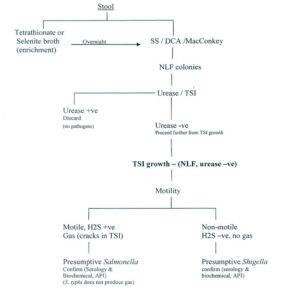Stool Culture
The stool culture is a diagnostic test that detects as well as identifies pathogens that cause infections of the lower digestive tract.  The test distinguishes between the pathogenic and non-pathogenic bacteria in the digestive tract. It refers to the inoculation of specific agar plates with faces of the patient and incubation for 1-2 days to detect the presence of pathogenic bacteria within the bowel flora. (1)
The test distinguishes between the pathogenic and non-pathogenic bacteria in the digestive tract. It refers to the inoculation of specific agar plates with faces of the patient and incubation for 1-2 days to detect the presence of pathogenic bacteria within the bowel flora. (1)
Your doctor may suspect a pathogenic GIT invasion and prescribe this test based on different symptoms, including prolonged diarrhea, bloody diarrhea, mucus in stool, abdominal pain and cramping, and nausea. If diarrhea lasts for more than a 3-5 days, it may lead to complications such as dehydration or electrolyte imbalance that can prove life-threatening.
Other causes can be:
- You’re very young or elderly
- You have a weakened immune system
- You’ve traveled outside the United States
- You’ve eaten contaminated food or water
Figure 1: Stool Culturing technique flowchart (2)
The stool culturing technique detects the presence of a pathogen or the characteristic features of the group to which the pathogen belongs. Its sensitivity is 54%, and a series of tests are performed to confirm the diagnosis of a specific causative agent. To establish a diagnosis, tests like PCR are performed that have much more specificity.
References:
- Hewison, C. J., Heath, C. H., & Ingram, P. R. (2012). Stool culture. Australian family physician, 41(10), 775–779.
- Figure 1 source: https://www.researchgate.net/figure/Flow-diagram-of-stool-culture-processing_fig2_308100231

